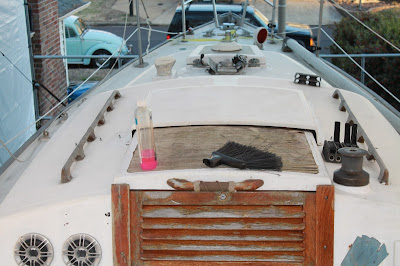Summer is winding down, I am finishing up a few side projects and soon the very serious refit work will begin. This week I began to formulate a plan of attack for Salacia's topsides. I spoke with a few people throughout the week for some guidance on how and where to begin (thank you James, Neil , Matt and John). I always like to get different perspectives on how to approach things...especially things I am not 100% familiar with (e.g. fiberglass boat deck repair.)
After speaking with these guys, I have come up with a plan.
I will first attack the re-coring of our Alberg 30's deck. This will be a very time-consuming job. I will add many improvements to the coring so hopefully this will be a once-in-my-lifetime job. I will add some structural support at the mast base throughout the deck, especially where the deck will see heavy forces applied to it.
I am hoping to get started on it in the coming weeks.
I have to keep looking at the great pictures of our time sailing Sal to remind me why I am doing this!
Approximately two years ago her decks looked 1000% better than they do today.
This was taken this afternoon. We now have about 90% of her decks stripped of fitting, nuts and bolts. By next week we should be at 99.9%
Removed the inner jib tracks, and I was amazed at just how easily these came off. I figured they'd put up more of a fight, but I'm thankful they didn't. They were so easily removed that I can now see how water had penetrated the bolts and holes in the deck to saturate her deck core.
I am sure this is the first time these tracks have been removed in all of Sal's 44 years.
The gathering of supplies:
I have begun to gather the supplies needed to start her refit. I have known for some time that epoxy would be used in every project, especially the decks. Over the last few months I have started to stock up on West Systems epoxy. This epoxy is used throughout the boat building and repair industry. It is so easy to use that even I have been able to figure it out. There are many other brands and I am sure they all work great but I have chosen West Systems because so many people consider it idiot proof and I can buy it at a pretty good discount. I think I have enough to get me started making a mess!
I gathered up some core material as well. I recently bought six 2ft x 4ft sheets of end grain balsa core. This is what was used originally to core the later-model Alberg 30's decks. It is the same balsa wood material used to make model airplanes. While it seems flimsy in model airplanes, when cut perpendicular to the grain balsa wood is actually quite strong. I was surprised when I first learned this. I had considered some other waterproof types of core material but they were just too expensive. I believe if I am careful and take appropriate measures I can make the deck 100% waterproof.
While I am nervous about cutting open the decks of my Alberg 30, I am very anxious to get started on the next step of the rebuilding process. Looking at her deck and hull completely stripped down has me feeling a bit glum and worried about the scope of the work ahead.
Be sure to stay tuned.


























